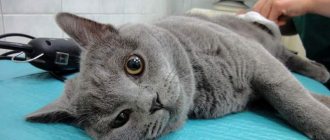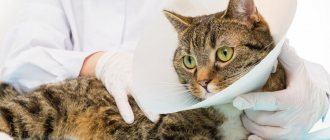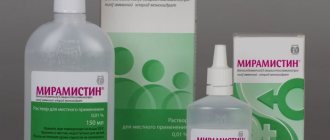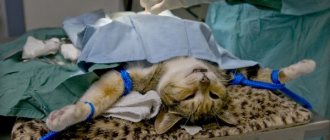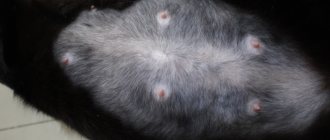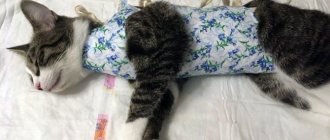- July 11, 2019
- Cats
- Irina Tsirikhova
“We are responsible for those we have tamed” - these words of A. Exupery should be remembered by those who are planning to get a cat or other living creature. Our little brothers have many needs, and you should be aware of this, since the owners will have to bear responsibility for the consequences. For example, the appearance of offspring is a big problem. The solution may be sterilization. How long does it take for cats to recover from anesthesia after it and how does this happen? This process is not easy and requires preparation.
Animal needs
Why do people even get cats? We are talking specifically about “girls”, since their appearance in the house means that soon, at least in a year, “happiness” awaits you in the form of additional meowing from several more living creatures. In addition, before this you will be faced with the needs of your pet, which she will loudly declare. That's right - she's in heat and she needs a cat.
If you have a purebred aristocrat, then the problem of a partner for her becomes even more complicated - not every cat is suitable. As they say, purity of blood comes first. If you have an ordinary cat, then the cat issue still requires a solution, but it may happen that the cat herself will show enterprise, and you will learn about her choice when she lambs.
By the way, she can repeat this about 4 times a year.
Did you know about this? It is possible that such a prospect has not occurred to you, but these are the realities. And so, after sound reflection (and it’s good if they visit you before the offspring appears), you began to think about sterilization. How cats move away after it and what consequences this process is associated with - this is what we will discuss.
Real life
The lifespan of a pet depends on many factors - living conditions, feeding, breed and frequency of reproduction of offspring (if it is a female). Too often repeating the process of childbearing shortens a cat's lifespan. In addition, several times a year owners have to solve the problem of arranging newborn babies, and there can be from 2 to 6 of them. You can, of course, approach the issue radically, but few people today would raise their hand to drown the kittens.
On average, cats live from 5 (street) to 15 (indoor) years. The courtyards walk on their own and breed as they please. The offspring grow up and join the ranks of “street children”, which is associated with diseases (including sexually transmitted diseases), death from natural causes or at the hands of child predators (which is often the case lately).
Volunteers are trying to solve the problem of uncontrolled reproduction of stray animals through sterilization. But this is a drop in the bucket...
Two ways to solve the problem
The solution to the problem for pets may be either taking pills that eliminate the appearance of sexual desire, or sterilization. How long cats go away after it depends on their state of health. However, it is possible to assume a general algorithm for the rehabilitation process.
But before you think about how long a cat will live after a sterilization operation, you need to decide on the possibility of this option.
It is no secret that there are plenty of prejudices against this procedure, and there is also a moral aspect - after all, you are depriving your pet of the joys of love... Here everyone decides for himself, if you are afraid, then it is better to choose another option.
In this case, you will consciously meet each new generation of your pet, and your responsibilities will also include casting the prospective partners of your cat. This is necessary, because otherwise she will face hormonal imbalance and health problems, not to mention a change in mood during the period of estrus.
Sterilization or castration?
First of all, the owner of the animal must decide what to do: sterilization or castration. These two procedures are different from each other. During sterilization, the ovaries are removed or the uterus is removed, but the ovaries are not touched. With this operation, estrus continues, but kittens do not appear. The animal's hormonal environment subsequently becomes unstable, and even in rare cases pregnancy is possible.
Castration is the removal of the uterus and ovaries. In this case, the production of estrogen stops, and hormones after such an operation become more stable because the adrenal glands are involved in the production of hormones.
How does the operation work?
During the operation, the animal is under general anesthesia. Seam position may vary. It may appear as a white line on the abdomen or as a small dot on the side. In the first case, such a suture is applied in the presence of inflammation. In the second, the operation is performed with early castration. The second operation is much simpler. In any case, the incision site must be treated constantly.
The choice is made
This part of the article is intended for those who have made their choice and now want to know how long a cat will live after sterilization and how to care for it after surgery.
Before moving on to the details, I would like to reassure the owners about the pet’s quality of life. Thanks to the stabilization of hormonal levels, she will become calmer and more affectionate, show more intelligence, and her life years will increase by 5 or 10 years, and she will be able to celebrate 20 or more birthdays. This is due to the fact that cats spend a lot of physical effort on bearing and raising offspring. And if you consider how many times during their lives they do this, it is not surprising that the payment for this is measured in years.
Well, to the question of how long it takes for cats to recover from anesthesia after sterilization, we answer: from 2 to 3 days.
What else do you need to know
For a while, the cat litter should be replaced with paper . The fact is that particles of filler that get into the cut can cause infection. Also, after the operation, it is necessary to ensure that the suture does not bleed and is clean. If there is discharge, contact your veterinarian immediately as the wound may become infected. After sterilization, a cat requires special treatment. Pressing on the stitches may cause pain.
Sterilization for an animal is accompanied by great stress. In addition, the immune system weakens and the cat can be susceptible to various diseases, so you need to monitor its general condition: how much it eats, how it drinks, how it goes to the toilet.
two weeks for the cat to fully recover . When estrogen stops entering the body, pets begin to eat a lot. Metabolism slows down and the animal may gain weight. To prevent a cat from becoming obese, it is necessary that it moves more, you need to walk and play with it, and also provide food for its diet.
Details about sterilization
Of course, you should know that the sterilization operation can be of three types:
- The first option is a partial abdominal surgery, during which either the ovaries or the uterus are removed from the animal.
- The second option is also partial - the cat can simply ligate the fallopian tubes.
- The third option is complete sterilization, in which the uterus is removed along with the ovaries.
Your veterinarian can tell you about the details and consequences of each operation. He will confirm to you that it is better to sterilize a cat before her first heat. The optimal age is from 8 months to one and a half years. This way you will protect your pet from complications after sterilization. How long it takes for a cat to recover from surgery depends on the quality of your care. By the way, it is necessary to constantly monitor the animal in the first days, and therefore it would be useful to take a vacation.
General care characteristics
After sterilization, cats look dirty. There may be blood on the fur. But bathing the animal for the first ten days is strictly prohibited . Avoid contact with water.
It is also very important to follow the following rules:
- do not give the animal any antibiotics;
- as a filler for the tray, use special store-bought sand, or even better, cut paper;
- change the filler and thoroughly “wash” the tray after each stool.
- Another important point that is very scary. After sterilization, animals often sleep with their eyes open. This is considered normal. To prevent drying out, you need to instill eye drops with a special solution. It is also recommended to close and open the animal’s eyelids every half hour while sleeping.
Caring for a cat after home sterilization requires not only patience, but also love.
Frightened and suffering from pain and hormonal changes, the animal needs affection. The owner’s emotional mood will help him survive this difficult period.
First 6 hours after surgery
So, you have chosen the most suitable option for surgical intervention and carried it out in the clinic. The procedure is completed, and your further actions for several hours will be to wait.
As a rule, after surgery, the animal’s condition should be monitored by a doctor. Therefore, the cat will sleep soundly during the first hours in the clinic. If her temperature is normal, then the patient can go home, where you will care for her as long as the cat recovers from anesthesia after sterilization. Further in stages:
- When your cat wakes up, you may be slightly frightened by her appearance: the expression in her eyes will be blank, the iris itself will be covered by the pupil. In addition, there will be no reaction to light. To restore the eyes, you should use “Artificial tear” drops, which moisturize the mucous membrane. The cat will not be able to blink on its own, and this is necessary, so the owner will have to help the pet by closing and opening her eyelids with his fingers. Next, you should continue to use the drops regularly to avoid conjunctivitis.
- In the first hours (from 2 to 5) after surgery, the cat may be subject to involuntary contraction of certain muscle groups. Don't be alarmed.
- The animal is very weakened, and therefore will have difficulty getting up on its legs. It is likely that the cat will not be able to do this in the first 5 hours. However, if after the 6th hour this has not happened (at least for 1 second), then you should return to the clinic for examination.
- The animal may meow and even simply scream after waking up. This is how cats recover from anesthesia. How long will this last? Normally it takes about 5 hours, but if it lasts longer, then something is wrong with her and she needs to worry about the doctor again. In principle, such an arousal reaction is quite predictable and similar to the human one.
Preparing a cat for surgery
Almost all difficulties that arise in the postoperative period are in one way or another associated with weak immunity. Therefore, before the operation it is necessary to take some measures to strengthen it. No later than a month before the planned date of the operation, the cat should be vaccinated against various viral diseases, and 10 days before, the animal should be given a drug against helminths.
2-3 days before surgery, you need to donate the cat’s blood and urine for analysis, as well as do an ultrasound examination of the heart muscle and respiratory organs. On the day of the operation, the cat should not be given food under any circumstances, and 3 hours before the procedure, drinking is completely excluded.
Long-term consequences and care
If the first 6 hours went normally, then this is not a reason to relax: how long cats recover from anesthesia after sterilization is a matter of the individual characteristics of the animal’s body. Let's follow the process further:
- After 6 (at best 5) hours, your pet will make weak attempts to walk. The sight is sad - she will even trip over a matchbox, not to mention collisions with furniture. The cat's gait will resemble Brownian motion - chaos and uncertainty. At this time, you are not just observing, but facilitating its safe movement across the territory. She can't jump (the seams will come apart) and your task is to help her climb onto and off her favorite sofa.
- This will continue for about a day, but with each passing hour your cat will become more and more confident in overcoming obstacles. For your peace of mind and its safety, you should not leave your cat for one day or the next.
- It will take about a day before she can start drinking and eating. If you start feeding her earlier, you will get a gag reflex. By this time, the condition of her eyes will be restored (with proper care).
- It should be noted that force-feeding a cat after surgery is completely unnecessary - she herself will feel when she needs to eat. After 48 hours or so, your pet may begin to compensate for the forced period of fasting. And this will be very obvious, since the animal is really hungry. To avoid complications, purchase special food for a sterilized cat.
- Your cat's behavior will be almost completely restored in three days, and possibly earlier.
How long does cat anesthesia last?
To learn more about the recovery time of cats that have been anesthetized, we need to look at how anesthetics work in felines. Anesthetic procedures in veterinary medicine consist of four stages:
© shutterstock
- Stage 1: premedication
The main purpose of administering medication before anesthesia is to create an “anesthetic cushion.” This helps reduce the chance of side effects, as well as reduce the stress, fear, and pain your cat may experience. Various combinations of the sedatives, muscle relaxants and analgesics mentioned above are used.
- Stage 2: administration of anesthesia
Injecting an anesthetic such as alfaxalone, ketamine or propofol causes the cat to lose its reflexes. This may allow intubation (inserting a tube into the cat's trachea to administer an inhalational anesthetic) to continue the anesthesia process.
These phases usually last about 20-30 minutes until the medications take effect and allow you to move on to the next phase.
- Stage 3: Maintenance
It consists of constant administration of an anesthetic. They will be administered in one of the following forms: inhalation, intravenous, intramuscular .
The length of this phase varies and will depend on the type of surgery your cat is about to undergo. If your cat is neutered, she will need less anesthesia, much the same as for a biopsy. If the foreign body is removed from the gastrointestinal tract, it may take a little longer. Surgeries for severe injuries can last several hours. Amounts will also depend on the skill of the veterinary surgeon and possible intraoperative complications.
- Stage 4: recovery
After the anesthesia wears off, resuscitation will begin. It should be quick, gentle, stress-free and painless as long as the correct medications are used and precautions are taken. It will be necessary to monitor the cats' condition and their temperature, as well as monitor for possible complications. This may manifest as fever, vomiting, etc.
In general, a well-fed, healthy cat will have a full recovery period after anesthesia of 2 days..
Some anesthetics last an hour or less, others last a few hours. With proper anesthesia protocol, pain management, vital signs and temperature monitoring by the anesthesiologist, your cat will be safe and will not feel pain or distress regardless of the duration of anesthesia.
Bibliography
- CM Acevedo, E. Gutierrez, A. Ortega. Sedation and pain relief. Veterinary vanguard. Available at: https://www.vanguardiaveterinaria.com.mx/sedacion-y-analgesia
- M. L. Goich. (2008). Opioid use in felines: benefits and complications. Veterinary portal. Available at: https://www.portalveterinaria.com/articoli/articulos/16961/uso-de-opioides-en-felinos-ventajas-y-complicaciones.html.
- F. G. Laredo, E. B. Mellado, M. Escobar. (2001). Accidents and complications during anesthesia in small animals II. Hospital Veterinary Clinic 30100, Murcia
- Unknown author. (2018). Is pain management dangerous for my cat or dog? Tucan Veterinary Hospital. Available at: https://hospitaltucan.com/anestesiar-perro-gato-peligroso/
Precautionary measures
And now, after you have found out how long it takes a cat to leave after sterilization, let’s discuss preliminary precautions. They must be taken into account before surgery and followed after it.
First of all, it is necessary to remember about the postoperative decrease in the animal’s body temperature. This means that you should take care of warm bedding and a blanket to provide a comfort zone for the cat.
After sterilization, your pet will need a blanket that will protect the seams from licking. It should be put on immediately after surgery and removed only to treat the incisions. A collar is needed for the same purpose.
In addition, the cat needs to arrange a rookery on the floor (in no case on an elevated surface), since in the first two days it will have problems with coordination, and it will not have enough strength to jump. In addition, if she falls off the sofa, the seams may come apart. It is better to place the cat on its right side to avoid strain on the heart.
Caring for a cat after sterilization
The veterinarian who performed the operation will tell you what proper care should be for the animal after sterilization. After arriving from the clinic, place the cat on a soft bedding covered with a sterile white cloth. Place the place or cat house on the floor or any other flat surface, but not on a hill, not in a draft or near heating devices.
When recovering from anesthesia, the cat does not control its reflexes. Sudden movements, jumping from heights, or accidental behavior can cause surgical sutures to come apart.
Important! During the first 24 hours, carefully monitor your cat’s behavior and condition. Do not leave the animal unattended.
In case of hypothermia, cover the animal with a blanket or warm blanket. Place a warm heating pad or plastic bottles filled with hot water under the backrest.
Feeding during rehabilitation
After waking up, 5-6 hours later, the cat can be offered a drink of water, but not food. Since the animal will be weakened, you can give it something to drink using a pipette or syringe without a needle. The pipette can be replaced with a Naphthyzin bottle, which is much more convenient.
The cat should be fed its usual food, but in case of any complications (after consultation with a doctor), you can switch to special postoperative food or boiled chicken meat.
After anesthesia, the animal may experience nausea. Before vomiting, a cat will usually lick itself frequently. The owner should not lose sight of the pet for a long time, as it may choke on vomit.
Temperature control
Temperature control is an important part of postoperative care. This should be done regularly using an electronic thermometer, inserting it into the animal's anus. For such manipulations, you will need an assistant.
If it is not possible to measure the temperature rectally, then use the old-fashioned method - feel the cat’s nose. If it is dry and hot for a long time (about 4 hours), then calling a specialist or transporting the animal to the clinic is highly recommended.
Monitor your pet's condition - the presence of a rapid heartbeat or rapid breathing indicates an inflammatory process in the suture area.
A slight increase in temperature of 0.5-1 degrees is quite understandable. In this case, the cat must be given water every half hour and the dynamics of its condition must be monitored. There should be no drafts in the room where the animal is located and a comfortable temperature should be maintained.
The main goal of all these precautions is to prevent complications in the cat.
How long does a cat sleep after anesthesia?
The duration of anesthesia sleep in cats and the recovery period depends on various aspects. The drug used and the method of introducing the animal into a state of sleep are taken into account.
If short-acting drugs are used, the condition required to perform the operation occurs quickly and the effect on the pet’s body stops just as quickly. Their scope of application is limited:
- dental procedures;
- nail removal;
- castration.
In general, they are used when a simple operation is required.
The modern method of gassing cats makes it possible to prepare the pet for surgery and, after just a couple of hours, return it to its original state. If deeper anesthesia is used, the period of postoperative sleep can reach eight hours.
If the veterinarian deems it necessary, he may recommend leaving the fluffy in the clinic for a while. Doctors not only know how to help a cat recover from anesthesia, but can also help the baby if breathing or heart problems arise.
In addition, a temporary hospital is a reason to save nerves, both yours and the animal’s. After all, when fluffies recover from anesthetized sleep, they can behave inappropriately. If you do not understand the methods that can normalize the animal’s psyche, the pet can be harmed, and the owners themselves will not be better off from the animal’s abnormal behavior.
When leaving the clinic, ask your doctor how long your pet will have to wean off the drug used in this case. Since the deadlines can be in a significant range of time, this question will be relevant.
Other manifestations
If you decide to undergo sterilization, then the willingness to show patience and care for your pet should be assumed a priori. Because your cat will need affection and understanding more than ever.
You should be prepared for the fact that the animal will experience involuntary drooling in the first hours after surgery. The cat may also try to crawl to a secluded dark place and hide there. Therefore, take into account her need for this when you make her bedding.
In addition, your cat may have involuntary discharge of feces or urine. Naturally, she should not be scolded for this.
And lastly: only after your pet returns to its previous lifestyle, you can leave it unattended for a long time.
How long does it take to sleep under anesthesia?
The duration of deep sleep in an animal can reach 7 hours.
The operation itself lasts about 25 minutes, but the cat sleeps under anesthesia during the first day and takes a long time to recover. During this time, the animal does not react to sounds, smells, does not eat or drink, and periodically wakes up. Very deep sleep, when the animal is as if unconscious, lasts about 7 hours, then the cat begins to move, but falls asleep again. If your pet cannot wake up beyond this period, you should urgently consult a veterinarian.
